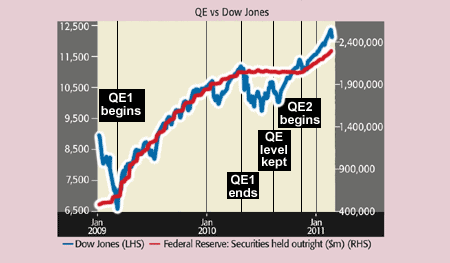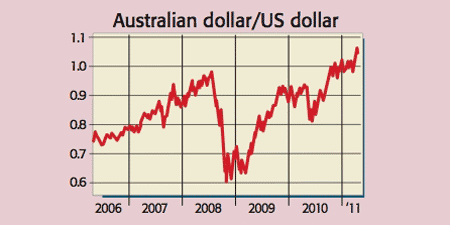What happens when quantitative easing ends?
Quantitative easing has been keeping the UK and US economies afloat since the financial crisis began. But America's $600bn money-printing programme is due to expire in June. So what can investors expect when the money tap is turned off? James Ferguson explains.
Is the Western money-printing bonanza about to end? Speculation is rife that the US Federal Reserve will signal an end to quantitative easing (QE) at the next meeting of the Federal Open Market Committee (the US equivalent of our own Bank of England's interest-rate-setting Monetary Policy Committee) on 27 April. In other words, once the current $600bn purchase programme (QE2) expires in June, the Fed will not renew it.
QE2 came on top of the initial $1.75trn-bout of QE, where the Fed used 'printed' money to buy mainly mortgage bonds. QE2 instead focused on buying Treasury bonds (US government IOUs), mainly those maturing in five to six years' time. In all (assuming QE2 doesn't end early, which seems unlikely), it'll add up to about $2.35trn, or some 16% of GDP. That's similar in terms of relative size to Britain's home-grown version of QE.
But if the QE stage of the attempt to resolve the crisis is indeed coming to a close, some big questions remain: what will the end of QE look like? And what will the impact be on markets and the economy? Since even Japan's QE was similar to our experience in name only, there is little or no historical precedent for what might happen after it ends.
MoneyWeek
Subscribe to MoneyWeek today and get your first six magazine issues absolutely FREE

Sign up to Money Morning
Don't miss the latest investment and personal finances news, market analysis, plus money-saving tips with our free twice-daily newsletter
Don't miss the latest investment and personal finances news, market analysis, plus money-saving tips with our free twice-daily newsletter
What happens when QE ends?
What does seem likely, logical even, is that whatever QE has done will cease, or even be reversed, when QE ends. As an 'unconventional' extension of normal monetary policy, QE was expected to do the same things that lower interest rates do. As well as promoting financial stability, reducing the cost of servicing debts, and underpinning asset prices, easy money boosts spending and increases inflation expectations.
But it's not all good. Loose monetary policy also means that savings drop and the currency weakens. This latter point makes the trade deficit worse, while the former is reflected in increased borrowing. Unusually low rates encourage borrowers to stick to short-term borrowing, exposing them to the dangers of rising rates.
But the worst consequence of QE is the economic inefficiency it creates. This may sound like a mild problem. But just as all crimes can be described in terms of theft, in many respects everything bad in economics can be boiled down to inefficiencies. This is why capitalism is such a successful model, because free markets are so very efficient at signalling accurate prices. These in turn inform participants' decisions and direct them to the most efficient outcomes.
QE short-circuits this otherwise very effective system. Sure, QE has its benefits it keeps rates low, inflationary expectations higher than they'd otherwise be, and money in plentiful supply. This prevents a deflationary recession. But unfortunately, it also delays the process of cleaning the system up 'creative destruction' is thwarted.
Poor, unprofitable and inefficient business models are allowed to stay in business. The low interest-rate environment encourages banks to exercise forbearance over borrowers whose collateral has dropped in value, or who are otherwise in breach of the terms of their loan agreements. In other words, borrowers who should really be pushed into bankruptcy and have their assets sold off are allowed to limp on regardless. Low rates also allow companies to survive on lower profit margins, which means that weak companies aren't squeezed out, but instead remain a barrier to entry for potential new and more entrepreneurial ones.
Now, we may well prefer the look of the economy with QE in place. For starters, it appears more normal. The restaurants are full, the shops are still open, fewer people than we would have expected have lost their jobs. In short, the pain has been spread as widely as possible via higher costs of living at the petrol pumps and the supermarket tills; and via higher taxes, as the government (in Britain for now, and in the America eventually) looks to cut back spending enough to keep the bond-market vigilantes in their box, so that future borrowing remains affordable.
This rose-tinted view is not 100% real, but it is nicer in the immediate term than its alternative. Given a choice between QE or harsh reality, Bank of England governor Mervyn King like Ben Bernanke in America decided we couldn't handle the truth and chose QE.

A lesson from Ireland
Not every country had the choice. Across the Irish Sea, the downside of eurozone membership has become all too apparent. Ireland illustrates what we could have expected to happen here if the German economy dictated the level of our interest rates and we had no power to do QE. QE in Britain amounted to £200bn of gilt purchases, about 14% of GDP. Before we can even contemplate what will happen when QE ends, we have to try and imagine what would have happened without it. And Ireland is as good an example as any.
British broad money supply over the last two and a half years or so has barely risen. This is not good. A more normal annual expansion rate is 6%-10%. But in Ireland, the stock of broad money has shrunk by 28%. This is the very definition of deflation. As a result, youth unemployment has soared, while property prices have already halved.
This is all very unpleasant, of course. But it does now mean that Ireland has cleaned out the dross, re-priced assets at the correct level and can now work at growing, though admittedly off a much lower base. I'm not saying that Ireland hasn't mis-handled several aspects of its crisis resolution particularly with regards to the treatment of its banks but what remains is by far the leanest, most competitive, and therefore most viable, of all the peripheral European countries.
The price that we and the Americans will pay for taking the 'easy' way out, and not facing up to the reality of the crisis, is at best a long workout period dealing with imported inflation and huge government debt; and at worst, another, deeper crisis once our ability to buy time runs out.
Could Britain see more QE?
So, have we really weaned ourselves off QE yet? Probably not in this country, but perhaps so in America. Why do I say that? Because the intellectual arguments backing QE have been very different on either side of the Atlantic. Over here, Mervyn King has issued a pretty clear guideline about what would constitute grounds for the launch of QE2 in Britain we'll get to that in a moment.
The American rationale, on the other hand, has always been more opportunistic and political in nature. In the States, the first version of QE specifically targeted residential mortgage-backed securities (RMBS) and was big enough to buy up almost the whole market. The idea was that QE would push long-term bond yields down by adding a major new buyer to the market. By targeting RMBS specifically, the cost of 30-year fixed-rate mortgages was expected to come down. The hope was that this would both support house prices and make it easier for existing homeowners to re-mortgage at cheaper rates. That in turn would put more spending money in their pockets at the end of each month, and help to reflate the economy.
But it didn't really work out like that. When the programme began, 30-year fixed-mortgage rates were just above 5%, but in the two years since QE started they have averaged 4.95%. This is no different to Treasury yields, which are also roughly flat over the last two years. And QE2 has had an even worse track record. Even though it specifically targeted Treasury yields, and particularly five-to-six-year maturities, the five-year Treasury yield has actually risen since QE2 began, from as low as 1% to more than 2% (whereas buying bonds aggressively should boost the price, taking the yield down).
Why has this happened? Because whatever the Fed's intention might have been, it is now clear that QE works to boost not so much the prices of the bonds that it targets, as the inflation expectations of the market.
Inflation is bad news for bonds a fixed income becomes less attractive as inflation picks up. So that in turn leads to the selling of non-inflation-protected bonds and the buying of inflation hedges, especially of imported goods, since QE also implies a weaker currency due to the increased excess money supply. The assets that have benefited most from QE, therefore, are not bonds and houses, as the Fed had originally intended, but stocks and commodities instead.
Here in Britain, however, King has always made it very clear that the Bank of England had no plan to manipulate markets. As he noted in a speech last September, he sees a central banker's main role as maintaining the money supply and that means guarding against it contracting (which is deflationary) in particular. Our QE was proportionally larger than the US version and at the time roughly matched the size of the contraction in bank lending. King was clear: even though banks were repairing their balance sheets (and therefore not keen to lend as much to the likes of you and me, because they only want to hold 'safe' assets), the money stock would not be allowed to shrink.
Sure enough, it hasn't. British broad money growth has been very anaemic but it hasn't gone negative, and that has been a vital part of the Bank's damage-limitation exercise. But it also implies that we may well get our own version of QE2, regardless of what the Americans do themselves. Why? Because if banks in Britain continue to shrink their lending, as they are currently doing, then money supply growth may well slip dangerously close to zero once more, especially now that the coalition government's long-anticipated austerity measures are kicking in. King has been explicit about this. If money supply looks like it might shrink, the Bank will buy more gilts again.
As for America, Fed chairman Bernanke told Congress recently that "downside risks to the economy have receded and the risk of deflation has become negligible". This bold statement looks somewhat over-confident. Although America no longer publishes the broad money measure M3, similar measures suggest that US broad money growth, which had been negative for the last year, is even now only flat on last year. So further QE isn't out of the question. But without specific criteria from Bernanke, it's hard to say exactly how he would justify moving onto another batch at least, not without seeing some sort of very clear shock to the economy or stockmarket.
Deflation is still a threat
Of course, just because QE2 ends doesn't mean the whole process is over. Not by a long chalk there's the whole question of the resale of the assets that the Fed and the Bank of England bought during the process, for one thing. In America they're talking about gradually selling off assets bought under QE ahead of rate rises; in Britain the plan is to start rate rises before any gilts bought under QE are put back on the market. But the principle remains the same. QE represents extraordinary monetary easing, beyond anything we've seen in this country for more than 340 years it's what you do only once rates have effectively reached zero. A return to normality requires not only that base rates get back at 5%-plus, but that all QE assets held on central banks' balance sheets are sold back to the private sector.
So the one thing we can say with certainty is that the end of QE will be a long, drawn out process, not an overnight shutdown. It's more likely to take years than months. Secondly, its implementation will probably be imprecise and staggered. Thirdly, we can be sure that the end of QE will be deflationary, though not as much so as its actual withdrawal (when the central banks start selling assets off and raising interest rates).
This is why the deflationists (like me) are so complacent in the face of high headline inflation numbers. They know that this apparent mild inflation has been the result of aggressive monetary easing on an unparalleled scale. If the duck stops paddling quite this hard, the system is in danger of crashing back into a deflationary spiral again, especially once fiscal stimulation (government spending) is reversed.
The UK government has started on its fiscal rectitude programme in earnest this month, with taxes rising and spending being cut. Meanwhile, the US will follow the end of QE2 in June with the final fiscal year of Obama's Democratic presidency from October. It seems unlikely that the Republican party will be keen to boost his chances of re-election by allowing a deficit-expanding spending programme to get past Congress. Credit rating agency S&P's decision to put US debt on negative watch will only hammer home this point (see page 16 for more).
To sum up, QE, or the threat of QE, may be around to haunt us for a while longer. For as long as banks are repairing their finances, they'll be shrinking loans and that means the money supply is under threat. During that time, central bankers will be keeping an eye on money supply growth and topping up any shortfalls with further QE. So there's a chance that we'll see further batches of QE in the future.
The end of the latest batch, however, has to be seen as a risk for investors, especially in America. It means an end to what we have come to take for granted. Indeed, the end of fiscal stimulation (ie, government cutbacks and tax hikes) would, all other things being equal, call for more QE, not less. As it is, these new fiscal headwinds don't necessarily imply that there will be further QE. But it does suggest that we should prepare for lower levels of inflation and nominal economic growth. The quid pro quo may well be higher bond markets and developed world currencies which has implications for investors, as I note below.
What to buy and sell as QE peters out
What are the implications for the end of quantitative easing (QE)? Investment-wise, it means the commodities run may be getting tired, as might all its various off-shoots, including the strength in the Australian dollar (AUD) which benefits from high commodity prices and the mining sector. Apart from diluting the currency that's being printed (in this case the US dollar), QE also mainly acts on inflation expectations it raises them. So whereas the impact on bonds is the opposite of what was expected (overall, QE has pushed their prices down, despite the central banks acting as massive buyers), the impact on stock prices appears to have been direct, immediate and positive.

Remove QE and we can expect these trends to reverse. That would mean a correction in stocks, especially those geared to the economic cycle. Meanwhile, despite the grim underlying picturefor government debt in many countries, bonds may rally. In short: as QE peters out, reverse all QE trades. So sell miners, commodities, commodity currencies (the Australian dollar looks the most vulnerable, but there's also the Canadian dollar), economically sensitive stocks, and property. As for what to buy? Stick with high-yielding defensives, developed-world currencies, and bonds (I'd favour governments over corporates and investment-grade over high-yield). As for gold, it may suffer as QE ends, but it's worth holding as insurance.
James Ferguson is head of strategy at Arbuthnot Securities.
Get the latest financial news, insights and expert analysis from our award-winning MoneyWeek team, to help you understand what really matters when it comes to your finances.
James Ferguson qualified with an MA (Hons) in economics from Edinburgh University in 1985. For the last 21 years he has had a high-powered career in institutional stock broking, specialising in equities, working for Nomura, Robert Fleming, SBC Warburg, Dresdner Kleinwort Wasserstein and Mitsubishi Securities.
-
 January Premium Bonds winners announced – did you win £1 million?
January Premium Bonds winners announced – did you win £1 million?More than 2.6 million historic Premium Bonds prizes are still waiting to be claimed, NS&I says
-
 Millions of parents are missing out on up to £720 a year in extra pension cash – are you affected?
Millions of parents are missing out on up to £720 a year in extra pension cash – are you affected?A mum who narrowly missed out on the pension boost said she “never knew the government rule existed” and wants other parents to use it